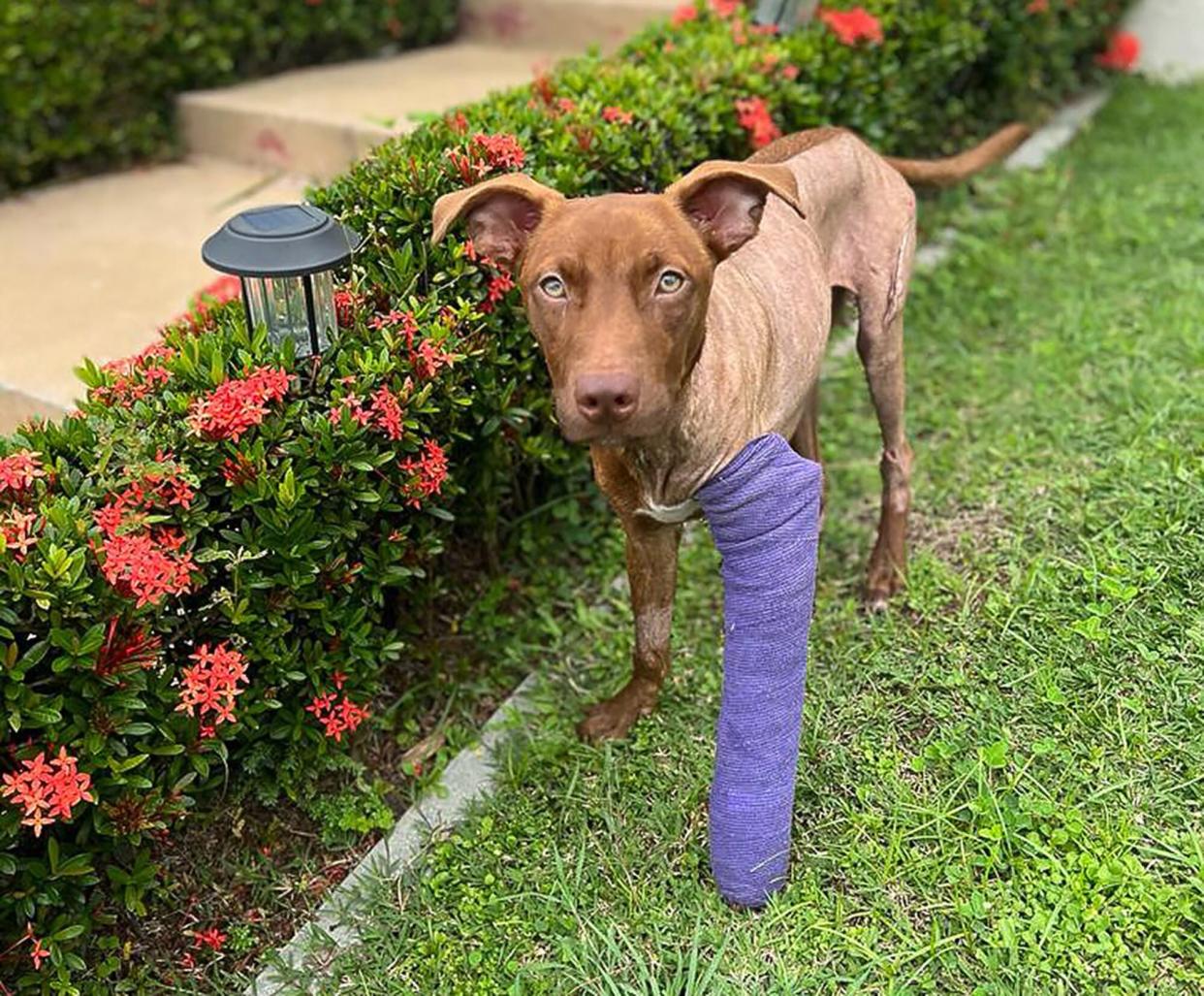How a Little Pup Who Was Hit By a Car Is Inspiring Animal Rescuers in Puerto Rico After Hurricane Fiona

Courtesy of The Sato Project
A small but very fitting inspiration has emerged in Puerto Rico as the island deals with the devastation of yet another natural disaster.
That would be Tony, a 1-year-old dog who was hit by a car days before Hurricane Fiona slammed into the island Sunday. Thanks to volunteers and staff from The Sato Project and some timely surgery, he survived.
With left legs full of plates and screws, he's only just now able to stand. But videos of his sweet face and wagging tail alongside his big, purple cast have buoyed spirits at The Sato Project after he sheltered from the storm at the organization's sanctuary. He's now a frequent source of good news as the project's team again tries to help the island's animals post-disaster.
"It means a lot to us that we can always have these dogs that we're able to help, to come back to. Like, 'OK, this is why we work so hard,'" Tara Steinberg, the project's communications manager, tells Daily Paws.
More survivors will join Tony's ranks in the coming weeks as The Sato Project and other Puerto Rico rescue groups again crack open their disaster recovery playbooks. The coming weeks will be a whirlwind of flight logistics, disease prevention, and aiding overcrowded, damaged shelters—with no guarantee another storm won't start the unfortunate process all over again.
Another Natural Disaster in Puerto Rico
Fiona made landfall as a Category 1 storm almost exactly five years after Hurricane Maria brought catastrophic wind and rain that leveled the U.S. territory's power grid and killed 3,000 people, according to the Associated Press.
Sandwiched between the two storms were a series of earthquakes in 2020 and the worst of the COVID-19 pandemic.
Fiona wasn't as devastating as Maria, but it dropped staggering amounts of rain to cause massive flooding and, like its predecessor, knocked out the power grid. The island never recovered from Maria, leaving its infrastructure even more vulnerable to Fiona.
"We're in a very, very fragile state right now down there, and our animals are in a very fragile state," says Luanne Czesak, The Sato Project's operations manager.
RELATED: What You Need To Know About the 4,000 Beagles Being Rescued From a Virginia Breeding Facility
Along with the ongoing humanitarian crisis, there's plenty of looming danger for Puerto Rico's animals, too. The Sato Project estimates that some 500,000 stray dogs and 1 million stray cats live on the island, not to mention the animals living in the very few shelters on the island—which are overcrowded and now damaged.
Some pet dogs will likely join the large populations of strays in the coming weeks. To save themselves, families might have to make the heartbreaking decision to abandon the pets they love. The shelters are too crowded.
"There's not a lot of great options," Steinberg says.
The immense amount of standing water on the island is another problem, especially paired with all the strays. The unmoving water is a breeding ground for diseases like leptospirosis, meaning the island is at a "high risk" for an outbreak, Czesak says.
Rescue Flights and Vaccines
The Sato Project is based in New York City, but its team in Puerto Rico (including the organization's founder, Chrissy Beckles) has managed to communicate with the office as power and water service gradually returns.
Its top priority is getting animals off the island. As of Thursday afternoon, the project had planned four rescue flights to the island, the first scheduled for Saturday. A private jet will bring animal and humanitarian supplies to the island and then depart with 30 bottle-fed kittens and puppies, "who are needing constant care," Steinberg says.
The quick response is reminiscent of the Maria aftermath, when the project also organized a flight in a matter of days.
"After that, unfortunately, we sort of are always in a state of disaster response it feels like," Steinberg says.
Those little ones will head to the Humane Society of Broward County in Florida. More flights will follow in what will be a months-long process, Czesak says. (The Sato Project often partners with Wings of Rescue, which flies pets from overcrowded shelters or disaster zones.) Ideally, taking animals to the mainland frees up space in the Puerto Rican shelters—allowing their staff to repair damage or take in other animals, like the ones families were forced to abandon.
"It means we can hopefully better equip them to deal with the next wave of this crisis," Czesak says.
RELATED: The U.S. Saw More Dogs and Cats Killed in Shelters Last Year, the First Increase in 5 Years
Vaccinations are another priority. With a lepto outbreak looming—not to mention the potential spread of parvovirus, heartworm disease, or mosquito-carried illnesses—The Sato Project is planning to send down veterinary staff to set up clinics and vaccinate as many dogs as possible.
As for Tony, he's still doing his job as a joy generator while all the busy work goes on around him. Czesak said if his rehabilitation goes well, he might be able to fly to the mainland in December.
"The shining light through this whole thing has been the videos that they were sending us of Tony, and he's still wagging his tail," she says.
How To Help
You don't need a private plane to help, though we're sure organizations like The Sato Project or Wings of Rescue could use it. But donations help fund those flights, and if you're near one of the project's partner shelters, you can foster or adopt the rescued animals.
Heck, you can keep a lookout and see if maybe Tony arrives at a shelter near you.
Steinberg also urges people to keep talking about Puerto Rico, not letting it leave the public discourse like it eventually did post-Maria. Without continued awareness—and necessary infrastructure improvements—we'll be here again when the next storm hits.

